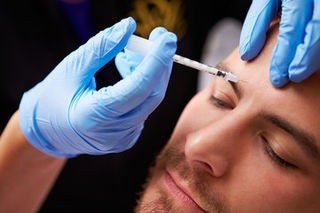Neuroscience
How Facial Botox Changes Your Brain—Literally
The limited facial paralysis alters the brain’s sensory maps of the hands.
Posted January 3, 2015 Reviewed by Lybi Ma

[This column was updated on 3/5/19.] The Injection of Botox to reduce facial lines and wrinkles has long been assumed to be purely cosmetic in nature. Hollywood’s rush to it has normalized the procedure and even given it an air of frivolity.
Ongoing research, however, has revealed an unintentional and rather alarming consequence: Botox injections in the forehead and face rearrange the brain’s sensory map of the hands. What's concerning is that clients typically come back for regular injections, because the limited paralysis the toxin induces lasts only two to three months. The ongoing question is whether repeated treatments over a period of years result in permanent changes to one’s brain [1].
Botox is the brand name for botulinum toxin–a, one of the most lethal poisons known. The neurotoxin is produced by the bacterium Clostridium, a spore commonly found in plants, soil, water, and animals. The clinical syndrome of botulism, which is often lethal, typically occurs from either a wound infection or eating undercooked or improperly canned food. The toxin paralyzes muscles by blocking the release of acetylcholine, the principal neurotransmitter between nerve and muscle.
For a long time, we have known that the brain is plastic, meaning that its circuits and microscopic anatomy are malleable. They physically change in response to a number of external inputs. For example, in violinists, the brain map devoted to the non-bowing fingers is much larger than the same finger region in non-violinists. In newly blind individuals learning braille, the cortical area devoted to the “reading finger” greatly expands into the newly unused visual cortex.
The brain maps of hand and face territories lie next to one another in the sensory cortex. After hand amputations, tactile inputs from the face routinely widen and shift into the territory newly deprived of sensory input from the hand. Likewise, patients with facial paralysis due to Bell’s palsy or stroke have enhanced metabolic activity in the hand region of the sensory cortex. The principle is well established that the cortical representation of one body part widens in response to injury affecting another body part.
Based on this knowledge one would expect hand maps to increase after a patient’s face is paralyzed by Botox injections. And yet exactly the opposite happens. This suggests that the cortical reorganization to Botox facial paralysis is intrinsically different from that observed after functional loss from amputations, facial nerve injury, or stroke. We must account for this within the established knowledge that during intentional imitation of facial expressions, facial feedback alters neural activity within central circuits underlying emotion [2].
The current explanation for this counterintuitive observation is that the limited paralysis caused by Botox deprives the brain of sensory inputs normally generated by forehead and facial movement. Even more unexpected is that both hands suffer a loss of cortical brain activity following a relatively small loss of facial movements. The changes in brain remapping are dose-dependent: the more you use, the bigger the effect. Initial studies did not investigate whether cortical remapping was limited only to the hands, or whether other body parts were also affected. Later studies showed more widespread effects and unintended consequences within the nervous system. It is an uncertainty that all who elect this "cosmetic" procedure should ponder. If this topic strikes a note, drop me a line.
References
[1] "Altered cortical activation from the hand after botulinum toxin treatment." Ann Clin Translational Neurol 2014, 1:64-68 by Arko Ghosh and colleagues was the earliest reference to this phenomenon. See http://onlinelibrary.wiley.com/doi/10.1002/acn3.21/pdf Subsequent work by Dr Ghosh and others can be found at google scholar or PubMed.
[2] Weise, D., Weise, C., & Naumann, M. (2019). Central Effects of Botulinum Neurotoxin—Evidence from Human Studies. Toxins, 11(1), 21.


